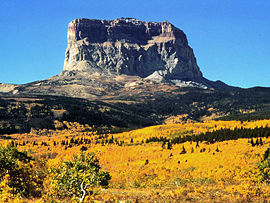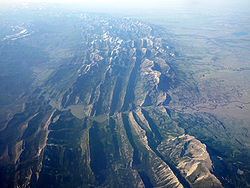
Lewis Overthrust
Encyclopedia


Rocky Mountains
The Rocky Mountains are a major mountain range in western North America. The Rocky Mountains stretch more than from the northernmost part of British Columbia, in western Canada, to New Mexico, in the southwestern United States...
within Glacier National Park in Montana
Montana
Montana is a state in the Western United States. The western third of Montana contains numerous mountain ranges. Smaller, "island ranges" are found in the central third of the state, for a total of 77 named ranges of the Rocky Mountains. This geographical fact is reflected in the state's name,...
, USA and Waterton Lakes National Park
Waterton Lakes National Park
Waterton Lakes National Park is a national park located in the southwest corner of Alberta, Canada, and borders Glacier National Park in Montana, USA. Waterton was Canada's fourth national park, formed in 1895 and named after Waterton Lake, in turn after the Victorian naturalist and conservationist...
in Alberta
Alberta
Alberta is a province of Canada. It had an estimated population of 3.7 million in 2010 making it the most populous of Canada's three prairie provinces...
, Canada
Canada
Canada is a North American country consisting of ten provinces and three territories. Located in the northern part of the continent, it extends from the Atlantic Ocean in the east to the Pacific Ocean in the west, and northward into the Arctic Ocean...
, as well as into Lewis and Clark National Forest
Lewis and Clark National Forest
Lewis and Clark National Forest is located in west central Montana, United States. Spanning , the forest is managed as two separate zones. The eastern sections, under the Jefferson Division, is a mixture of grass and shrublands dotted with "island" pockets of forested areas. Here, cattle leases to...
. It provides scientific insight into geologic processes happening in other parts of the world, like the Andes
Andes
The Andes is the world's longest continental mountain range. It is a continual range of highlands along the western coast of South America. This range is about long, about to wide , and of an average height of about .Along its length, the Andes is split into several ranges, which are separated...
and the Himalaya Mountains. Scientific study of this region is practical because the original rock characteristics were well-preserved and recently sculptured by glacier
Glacier
A glacier is a large persistent body of ice that forms where the accumulation of snow exceeds its ablation over many years, often centuries. At least 0.1 km² in area and 50 m thick, but often much larger, a glacier slowly deforms and flows due to stresses induced by its weight...
s. The Lewis
Lewis Range
The Lewis Range is a mountain range located in the Rocky Mountains of northern Montana, U.S. and extreme southern Alberta, Canada. Formed by the Lewis Overthrust beginning 170 million years ago, an enormous slab of Precambrian rocks 3 miles thick, wide and long faulted and slid over newer...
and Livingston
Livingston Range
The Livingston Range is a mountain range located primarily in Glacier National Park in the U.S. state of Montana, and in the extreme southeastern section of the Canadian province of British Columbia. The range is long and wide. Over 15 summits exceed above sea level, and the highest point is...
mountain ranges are the visible reminders of this fault. The Rocky Mountain Front
Rocky Mountain Front
The Rocky Mountain Front is an area extending over 100 miles from the central regions of the U.S. state of Montana to southern Alberta, Canada. Here, the Rocky Mountains meet the Great Plains and Canadian Prairie in an abrupt elevation rise of between 4,000 to 5,000 feet...
is the easternmost portion of the Lewis Range which rises abruptly 4000 to 5000 ft (1,219.2 to 1,524 m) above the Great Plains
Great Plains
The Great Plains are a broad expanse of flat land, much of it covered in prairie, steppe and grassland, which lies west of the Mississippi River and east of the Rocky Mountains in the United States and Canada. This area covers parts of the U.S...
.
The Lewis Overthrust started during the formation of the Rocky Mountains 170 million years ago as a result of colliding tectonic plates. Stresses on the continental plates pushed a huge rock wedge eastward more than 50 miles (80.5 km). The rock wedge, which was several miles thick and several hundred miles long, consisted of ancient rock formations from the Precambrian
Precambrian
The Precambrian is the name which describes the large span of time in Earth's history before the current Phanerozoic Eon, and is a Supereon divided into several eons of the geologic time scale...
era. The underlying layer consisted of softer, Cretaceous
Cretaceous
The Cretaceous , derived from the Latin "creta" , usually abbreviated K for its German translation Kreide , is a geologic period and system from circa to million years ago. In the geologic timescale, the Cretaceous follows the Jurassic period and is followed by the Paleogene period of the...
age rocks that were over 1,400 million years younger than the overthrust layer.
Chief Mountain
Chief Mountain
Chief Mountain is located in the U.S. state of Montana on the eastern border of Glacier National Park and the Blackfeet Indian Reservation...
is a highly visible example of the Lewis Overthrust. The mountain is an isolated remnant (a klippe
Klippe
thumb|right|350px|Schematic overview of a thrust system. The shaded material is called a [[nappe]]. The erosional hole is called a [[window |window or fenster]]. The klippe is the isolated block of the nappe overlying autochthonous material....
) of the eastern edge of the upper plate. Erosion
Erosion
Erosion is when materials are removed from the surface and changed into something else. It only works by hydraulic actions and transport of solids in the natural environment, and leads to the deposition of these materials elsewhere...
over time has shaped the mountain into its characteristic shape, where it towers over the prairie.

